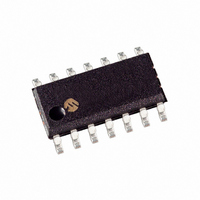HCS473/SL Microchip Technology, HCS473/SL Datasheet - Page 16

HCS473/SL
Manufacturer Part Number
HCS473/SL
Description
IC KEELOQ 3AXIS TRANSCODR 14SOIC
Manufacturer
Microchip Technology
Series
KEELOQ®r
Type
Code Hopping Encoder and Transponderr
Specifications of HCS473/SL
Applications
Access Control Systems
Mounting Type
Surface Mount
Package / Case
14-SOIC (3.9mm Width), 14-SOL
Lead Free Status / RoHS Status
Lead free / RoHS Compliant
HCS473
3.1.4
The following HCS473 configuration options configure
transmission characteristics of the information exiting
the DATA pin:
• Modulation select (MSEL)
• Header select (HSEL)
• Extended serial number (XSER)
• Queue counter enable (QUEN)
• Counter select (CNTSEL)
• Low voltage trip point (VLOWSEL)
• PLL interface select (AFSK)
• RF enable output (RFEN)
• Seed button code (SDBT)
• Time before Seed (SDTM)
• Limited Seed (SDLM)
• Seed mode (SDMD)
• RF baud rate select (RFBSL)
• Guard time select (GSEL)
• Minimum code words (MTX)
• Timeout select (TSEL)
• Long preamble enable (LPRE)
• Long preamble length (LPRL)
• Preamble duty cycle (PRD)
The following sections detail each configuration’s avail-
able options. All timing values specified are subject to
the specified oscillator variation.
3.1.4.1
The Modulation format option selects the modulation
format for data output from the DATA pin; most often
transmitted via RF.
MSEL options:
• Pulse Width Modulation (PWM), Figure 3-3
• Manchester Modulation, Figure 3-4
3.1.4.2
The synchronization header is typically used by the
receiver to adjust bit sampling appropriate to the trans-
mitter’s current speed; as the transmitter’s RC oscilla-
tor varies with temperature and voltage, so will the
transmission’s timing.
HSEL options:
• 4 RF
• 10 RF
DS40035C-page 14
TE
TE
ENCODER MODE OPTIONS
Modulation Format (MSEL)
Header Select (HSEL)
Preliminary
3.1.4.3
The Extended Serial Number option determines
whether the HCS473 transmits a 28 or 32-bit serial
number.
When configured for a 28-bit serial number, the Most
Significant nibble of the 32 bits reserved for the serial
number is replaced with a copy of the 4-bit button sta-
tus, Figure 3-2.
XSER options:
• 28-bit serial number
• 32-bit serial number
3.1.4.4
The QUE counter can be used to request secondary
decoder functions using only a single transmitter but-
ton. Typically a decoder must keep track of incoming
transmissions to determine when a double button press
occurs, perhaps an unlock all doors request. The QUE
counter removes this burden from the decoder by
counting multiple button presses and including the
QUE counter value in the last two bits of the 69-bit code
word, (Figure 3-2). If QUEN is disabled, the transmis-
sion will consist only of 67 bits as the QUE bits field is
not transmitted.
Que counter functionality is enabled with the QUEN
configuration option. The 2-bit QUE counter is incre-
mented each time an active button input is released for
at least the Debounce Time (T
(button pressed again) within the Queue Time (T
Figure 3-5. The counter increments up from 0 to a max-
imum of 3, returning to 0 only after a different button
activation or after button activations spaced greater
than the Queue Time (T
The current transmission aborts, after completing the
minimum number of code words (Section 3.1.4.15),
when the active button inputs are released. A button re-
activation within the queue time (T
new transmission (new synchronization counter,
encrypted data) using the updated QUE value. Button
combinations are queued the same as individual but-
tons.
Extended Serial Number (XSER)
Queue Counter (QUEN)
2002 Microchip Technology Inc.
QUE
) apart.
DB
QUE
), then re-activated
) then initiates a
QUE
),













